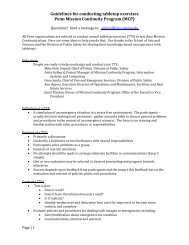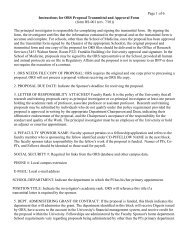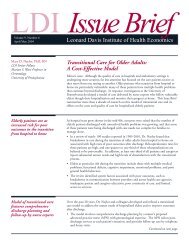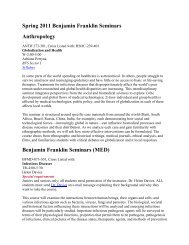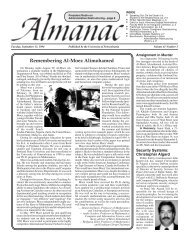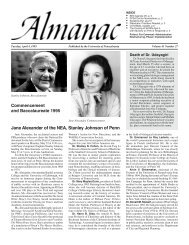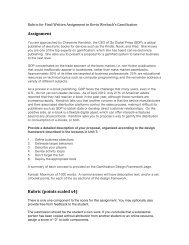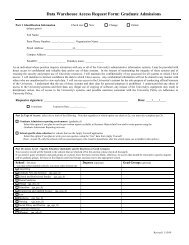2009-2010 COURSE REGISTER - University of Pennsylvania
2009-2010 COURSE REGISTER - University of Pennsylvania
2009-2010 COURSE REGISTER - University of Pennsylvania
You also want an ePaper? Increase the reach of your titles
YUMPU automatically turns print PDFs into web optimized ePapers that Google loves.
develops a different approach and project<br />
for their section <strong>of</strong> this studio.<br />
Studios incorporate the expertise <strong>of</strong><br />
external consultants in advanced areas <strong>of</strong><br />
technology, engineering and<br />
manufacturing.<br />
701. Design Studio V. (C) Faculty.<br />
A set <strong>of</strong> Advanced Architectural Design<br />
studios are <strong>of</strong>fered from which students<br />
select through a lottery. Topics and sites<br />
vary by instructor.<br />
702. Design Studio VI. (B) Faculty.<br />
In the final semester <strong>of</strong> the program,<br />
students select from three options: ARCH<br />
702, an advanced design studio, ARCH<br />
704, a research studio, the exploration <strong>of</strong>a<br />
topic or theme established by an individual<br />
faculty member or group <strong>of</strong> faculty<br />
members; or ARCH 706, an independent<br />
design thesis, the exploration <strong>of</strong> a topic or<br />
theme under the supervision <strong>of</strong> a thesis<br />
advisor.<br />
703. Post-Pr<strong>of</strong>essional Architectural<br />
Design Studio. (A) Dubbeldam.<br />
An Advanced Architectural Design Studio<br />
specifically tailored to post-pr<strong>of</strong>essional<br />
students. Through this studio, students<br />
engage in the challenges and opportunities<br />
presented by changes in society,<br />
technology, and urban experience.<br />
Through design projects, they explore<br />
alternative modes and markets for<br />
practice,along with new directions and new<br />
tools for design.<br />
704. Advanced Design:Research<br />
Studio. (B) Faculty.<br />
In the final semester <strong>of</strong> the program,<br />
students select from three options: ARCH<br />
702, an advanced design studio; ARCH<br />
704, a research studio, the exploration <strong>of</strong>a<br />
topic or theme established by an individual<br />
faculty member or group <strong>of</strong> faculty member<br />
or group <strong>of</strong> faculty members; or ARCH<br />
706, an independent design thesis, the<br />
exploration <strong>of</strong> a topic or theme under the<br />
supervision <strong>of</strong> a thesis advisor<br />
706. Independent Thesis. (B) Faculty.<br />
In the final semester <strong>of</strong> the program,<br />
students select from three options: ARCH<br />
702, an elective design studio, selected<br />
from among the design studios <strong>of</strong>fered for<br />
ARCH 602; ARCH 704, a research studio,<br />
the exploration <strong>of</strong> a topic or theme<br />
established by an individual faculty<br />
member or group <strong>of</strong> faculty members; or<br />
ARCH 706, an independent design thesis,<br />
the exploration <strong>of</strong> a topic or theme under<br />
the supervision <strong>of</strong> a thesis advisor.<br />
718. (EALC258) Japanese<br />
Architecture. (A) Steinhardt.<br />
An introduction to the visual, aesthetic,<br />
historical, religious, philosophical, and<br />
symbolic aspects <strong>of</strong> Japanese structures<br />
from earliest times to the mid-19th century.<br />
Through a discussion <strong>of</strong> shrines, temples,<br />
palaces, tombs, cities, and gardens the<br />
student will explore what makes Japanese<br />
architecture distinctive and how the<br />
traditions <strong>of</strong> Japanese architecture evolve<br />
over time.<br />
Graduate Visual Studies Workshops<br />
521. Visual Studies I. (A) Veikos and<br />
Faculty. Corequisite(s): Arch 501.<br />
The study <strong>of</strong> analysis and projection<br />
through drawing and computer<br />
visualization<br />
522. Visual Studies II. (B) Faculty.<br />
Corequisite(s): ARCH 502.<br />
A continuation <strong>of</strong> the study <strong>of</strong> analysis and<br />
projection through drawing and computer<br />
visualization.<br />
621. Visual Studies III. (A) Faculty.<br />
Corequisite(s): Arch 601.<br />
The final <strong>of</strong> the Visual Studies half-credit<br />
courses. Drawings are explored as visual<br />
repositories <strong>of</strong> data from which information<br />
can be gleaned, geometries tested, designs<br />
refined and transmitted. Salient strengths<br />
<strong>of</strong> various digital media programs are<br />
identified and developed through<br />
assignments that address the specific<br />
intentions and challenges <strong>of</strong> the design<br />
studio project.<br />
Graduate Required and Designated<br />
Courses<br />
L/R 511. History and Theory I. (A)<br />
Lahiji.<br />
The first <strong>of</strong> three required courses in the<br />
history and theory <strong>of</strong> architecture, this is a<br />
lecture course with discussion groups that<br />
meet weekly with teaching assistants. The<br />
course explores fundamental ideas and<br />
models <strong>of</strong> architecture that have emerged<br />
over the past three hundred years, with<br />
specific focus on constructive and<br />
generative models.<br />
L/R 512. (ARCH412) History and<br />
Theory II. (B) Leatherbarrow.<br />
This course traces the emergence <strong>of</strong><br />
contemporary issues in the field by<br />
exploring the architecture <strong>of</strong> the twentieth<br />
century. Buildings, projects, and texts are<br />
situated with in the historical constellations<br />
ARCHITECTURE<br />
<strong>of</strong> ideas, values, and and technologies that<br />
inform them through a series <strong>of</strong> close<br />
readings. Rather that presenting a parade<br />
<strong>of</strong> movements or individuals, the class<br />
introduces topics as overlaying strata, with<br />
each new issue adding greater complexity<br />
even as previous layers retain their<br />
significance. Of particular interest for the<br />
course is the relationship between<br />
architecture and the organizational regimes<br />
<strong>of</strong> modernity.<br />
531. (ARCH431) Construction I. (A)<br />
Falck.<br />
Course explores basic principles and<br />
concepts <strong>of</strong> architectural technology and<br />
describes the interrelated nature <strong>of</strong><br />
structure, construction and environmental<br />
systems.<br />
532. (ARCH432) Construction II. (B)<br />
Falck.<br />
A continuation <strong>of</strong> Construction I, focusing<br />
on light and heavy steel frame construction,<br />
concrete construction, light and<br />
heavyweight cladding systems and systems<br />
building.<br />
533. (ARCH433) Environmental<br />
Systems I. (A) Malkawi.<br />
An introduction to the influence <strong>of</strong> thermal<br />
and luminous phenomenon in the history<br />
and practice <strong>of</strong> architecture. Issues <strong>of</strong><br />
climate, health and environmental<br />
sustainability are explored as they relate to<br />
architecture in its natural context. The<br />
classes include lectures, site visits and field<br />
exploration.<br />
534. (ARCH434) Environmental<br />
Systems II. (B) Braham.<br />
This course examines the environmental<br />
technologies <strong>of</strong> larger buildings, including<br />
heating, ventilating, air conditioning,<br />
lighting, and acoustics. Modern buildings<br />
are characterized by the use <strong>of</strong> such<br />
complex systems that not only havetheir<br />
own characteristics, but interact<br />
dynamically with one another and with the<br />
building skin and occupants. Questions<br />
about building size, shape, and construction<br />
become much more complex with the<br />
introduction <strong>of</strong> sophisticated feedback and<br />
control systems that radically alter their<br />
environmental behavior and resource<br />
consumption. Class meetings are divided<br />
between slide lectures, demonstrations, and<br />
site visits. Course work includes in-class<br />
exercises, homework assignments, and a<br />
comprehensive environmental assessment<br />
<strong>of</strong> a room in a buildingon campus.<br />
L/L 535. (ARCH435) Structures I. (A)<br />
Farley. Corequisite(s): Arch 535.<br />
Page 39





